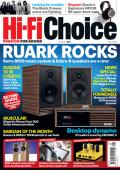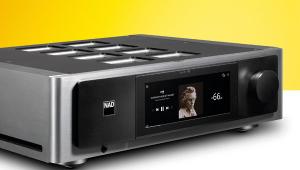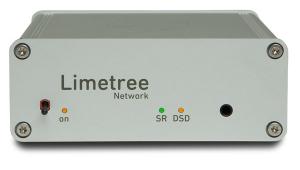Auralic Vega G1

 It has been a busy 18 months for network streaming specialist Auralic and both its £3,899 Aries G2 and £1,899 Aries G1 streaming transports – reviewed in issues 431 and 441 respectively – received high praise with coveted Recommended and Editor’s Choice badges for their implementation of one of the most capable and easy to use platforms available to network audio fans. The recently introduced Aries series represents a move to a new casework design and construction with both housed in beautiful black chassis with an attractive LCD colour display and tactile front panel controls.
It has been a busy 18 months for network streaming specialist Auralic and both its £3,899 Aries G2 and £1,899 Aries G1 streaming transports – reviewed in issues 431 and 441 respectively – received high praise with coveted Recommended and Editor’s Choice badges for their implementation of one of the most capable and easy to use platforms available to network audio fans. The recently introduced Aries series represents a move to a new casework design and construction with both housed in beautiful black chassis with an attractive LCD colour display and tactile front panel controls.
While both Aries transports will work with a huge selection of DACs, Auralic would of course like you to choose its own decoding and the Vega G1 is the matching option for its Aries G1 streaming transport. As with any DAC, the Vega takes the digital signal from the back of the Aries and turns it into an analogue output signal to be connected to an amplifier. Additionally, it has a selection of other functionality that puts it in a slightly different category to many other rivals, satisfying your network streaming requirements without the need to purchase the matching Aries.
Along with its streaming digital-to-analogue-converter capabilities, the rotary volume control on the front panel allows it to operate as a digital preamp to become the larger part of a digital music system housed in a single chassis. As well as the network port at the rear, other digital inputs include a USB-B port, AES, coaxial and optical connections selectable from the menu, plus stereo analogue outputs via stereo RCA and XLR sockets. There are also two 6.35mm headphone sockets on the front panel.
Internally, the Vega is equipped with audiophile components mated to hardware that’s more in keeping with a desktop computer. It features 1GB of DDR RAM and a quad-core processor to keep the streaming section running smoothly. This is partnered with an ESS Sabre DAC that ensures support for PCM up to 32-bit/384kHz and DSD512. In keeping with Auralic’s design philosophies, great attention has been paid to the clocking, with timing accuracy promised into the realm of femtoseconds as well as four digital filters to allow a degree of performance customisation.
The eye-catching 4in front panel display shows album artwork, track name (but not album title), track number and time elapsed. Using it to navigate system menus requires you to get up close to the screen, as the text size is very small indeed. There is no dedicated remote, but the large silver dial acts as a slick level control as well system menu options.
Sound quality
Hooked up to a Naim Supernait 2 integrated amp and Neat Momentum 4 floorstanding loudspeaker and taking a feed from a Melco N1A NAS drive (HFC 397), the Vega’s cut-down Lightning interface (see boxout)doesn’t like the library information it acquires from the Melco and falls back to organising it on the app alphabetically by song writer. This isn’t ideal, but thankfully selecting the Album List option from a sub menu allows it to see albums and organise them in the same way as the Melco.
Whatever the additional functionality of the Vega, its ability to deliver in terms of sonics is not compromised. Starting with a 16/44.1 rip of Yazz Ahmed’s Jamil Jamal gives a good overview of what it is capable of with a very well-judged balance between detail and an extremely vivid presentation that never tips over into sounding bright or overly forward, even when the recording isn’t one for the ages. Some of these traits can be identified as being down to the presence of that ESS Sabre DAC, which possesses a definite character of its own but there is also a tonal richness that continuously makes its presence felt. Ahmed’s trumpet is wonderfully vibrant and convincing with a notable decay to notes that brings a level of detail that ensures the Auralic delivers a performance rather than a mere reproduction.
If you ask for something a little more energetic, it responds admirably. The 24/48 remaster of Peter Gabriel’s Sledgehammer has the scale it needs to sound right and has an excellent and useful level of definition. The bass is pronounced without dominating and there is enough propulsive force to ensure it engages the listener. Compared with some rivals that last ounce of rhythmic excitement isn’t present, but this is something that could probably be achieved with some prudent system matching.
This is perhaps the most significant attribute of the Auralic. It would be wrong to say that it has no character of its own, but it comes across as a device that’s determined to give you the contents of any recording with as little of itself included as possible. Although it does offer a series of adjustable filters, these do not hugely alter the overall performance and I enjoy the consistently agreeable presentation of Precise, which appears to be the default setting.
Moving to the range of supported streaming services doesn’t really alter this balance of realism and transparency – serving instead as a reminder that this section of the Lightning app really is very slick indeed. Streaming The Cinematic Orchestra’s album To Believe – which benefits from a 24/48 release via Qobuz – sounds sumptuous on the Vega. There’s a wonderful coherence to the way that A Caged Bird/Imitations Of Life reaches the listening position with a remarkably open and three dimensional presentation. It is an annoyance that the browsing experience from a streaming service is better than the somewhat compromised experience viewing my own music library stored on the Melco NAS, but there is a solution to overcome this hiccup. As with the Aries models, the Vega is perfectly capable of being used as an end point for Roon’s playback software. The Auralic Vega G1 has a dedicated product profile, which automatically selects the relevant settings, and can be controlled over Ethernet via the Roon app. In the Aries models this feels a little superfluous, but here it works like the missing piece of the puzzle. If you aren’t planning on using the Vega G1 DAC alongside an Aries G1, then Roon is a transformative experience because it lets the Vega demonstrate its unquestionably excellent sonic performance while enjoying the control experience of Roon. Of course, this is not exactly a cheap solution and adding a lifetime Roon subscription at $499 to the cost of the Vega DAC takes the total expenditure to near £3,700.
Some other aspects of the Vega’s specification do help it look rather better value, though. The volume function enables it to offer considerable potential as a digital preamp and connecting it to a pair of active speakers, the Vega G1 gets an awful lot done in a single chassis. Running into the AV bypass function of my resident Naim Supernait 2 integrated amplifier, it displays a beautifully even volume ramp and the performance is utterly consistent from the audible threshold upwards.
Conclusion
Despite its undeniably impressive DAC and streaming capabilities, the Vega G1 is not the same straightforward solution as the Aries G1. At the price, it faces stiff competition and even though it has one of the best apps around, it is slightly handicapped. Despite this, the ability it demonstrates with such a wide selection of music, coupled to the excellent functionality and extremely solid build means that it can more than hold its own. Auralic’s golden run continues and we can’t wait to see what’s next. ES
DETAILS
Product: Auralic Vega G1
Price: £3,299
Origin: China
Type: Streaming DAC with preamp
Weight: 7kg
Dimensions: (WxHxD) 340 x 80 x 320mm
FEATURES
● Supports sample rates up to 32-bit/384kHz PCM and DSD512
● Wired Ethernet networking
● Digital inputs: 1x USB-B port; 1x coaxial; 1x optical
● Streaming support: Spotify Connect; Tidal; Qobuz; internet radio
● Roon compatible
Read the full review in May 2019 issue 449
 |
Inside this month's issue:
Ruark R610 music system and Sabre-R standmount speakers, PMC twenty.23i Active, floorstanders, English Acoustics Downton preamplifier, Bluesound NODE ICON preamp/streamer, Ortofon Concorde Music Blue MM cartridge and much, much more
|


















































